(This is the second of a five-part roundtable discussion of Sarah Hall’s How to Paint a Dead Man.)
Other Installments: Part One, Part Three, Part Four, Part Five
More on Hall: “The Early Fiction of Sarah Hall” and a one hour radio interview I conducted with Hall in 2008.
Miracle Jones writes:
“You turned instead to the place where all depraved civilian requests are made and met: the internet.” — Sarah Hall, How to Paint a Dead Man
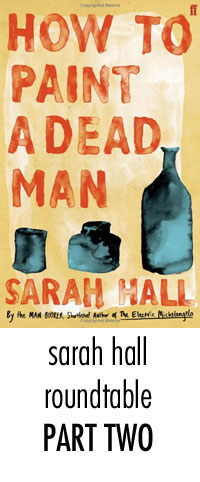 This book was chilly. Cold, cold, cold. Not just cold: frozen. Ordinarily, I distrust books that are so still and moody and arid, but I realized while reading How to Paint a Dead Man that I distrust those books because they don’t freeze anything worth looking at or worth taking the time to get your mind around. Sarah Hall’s novel is frozen solid — your tongue sticks to it — but it is still full of life, like a snow-buried city in the Antarctic or an ice cube stuffed with worms.
This book was chilly. Cold, cold, cold. Not just cold: frozen. Ordinarily, I distrust books that are so still and moody and arid, but I realized while reading How to Paint a Dead Man that I distrust those books because they don’t freeze anything worth looking at or worth taking the time to get your mind around. Sarah Hall’s novel is frozen solid — your tongue sticks to it — but it is still full of life, like a snow-buried city in the Antarctic or an ice cube stuffed with worms.
This book has assembled a whole helluva lot of interesting things — fast things, emotional things, beautiful things, above all ordinary things — and frozen them in time and space so that the artist can paint a truly remarkable still life. The kind of still life painting that gives Peter brief transcendence at the end of the novel, a painting of which he says “was nothing for a moment, and then was everything.”
I certainly couldn’t recommend this book to a casual reader. But that doesn’t mean it isn’t an artistic triumph even as it is not much of a page turner. Instead it is an exercise in shade and light that must have been exceptionally difficult to pull off. This book was far more engrossing than it should have been considering that there is no plot of which to speak. The only events that really “happen” in the book are Peter getting his foot stuck in a hole (which only freezes things further; and how else to freeze this hyperactive madman?) and Annette’s attack by the “Bestia” at the book’s end.
(Who is that “Bestia” by the way? Was I not paying enough attention? I want it to be Ivan or Peter on their Italian trip. I want that to be how Peter “unofficially liberated” the bottle that ends up in Susan’s collection.)
Ed, your question about structure is the most important consideration here. This book is all structure. Form, composition, and relationship. One must analyze this novel the same way one analyzes a serious, labored painting of dusty bottles on a table. The four cycling sections each have a different pronoun perspectives (you, I, she, he), each centering on a main character living in a different decade. Each of the characters are dealing with their own consuming “it,” their muse who is now dead and gone. They each deal with this loss through changing the nature of their art, even as they are physically altered by shifting circumstances.
Susan curates a show of personal effects, Peter conquers mountains (literally and on his canvases), Annette lives through flowers, and Giorgio has his bottles. There is a web of inspiration between the characters that is solidified by Susan’s affair with Tom (and its “fruit”), which ultimately makes a weird, circular nexus. Tom and Susan are clearly breeding the Kwisatz Haderach.
And that’s it. That’s the book. The neat and artistic delivery of a complicated structural form, wrapped in very beautiful language, sentence to sentence. But it is so clever when you consider the limitations! It is so neat and mathematical and attentive! Too convenient? Too contrived? Perhaps. But so what? This is the literary equivalent of “math rock.” If this were an album, it would be by King Crimson. It would be called Bottles.
If you were to make a movie out of How to Paint a Dead Man, how would you do it without contorting the plot into a flashback-riddled caricature? There’s no way. It could be black and white, with only the objects that connect the characters in color: Tom, Peter’s letters, the bottle, and of course all the paintings and sculptures.
I don’t think the Procrustean plot structure is this book’s weak point, however. I think instead the contrived plot elements are what make this book suffer, plot elements that throw into question the “realism” of our Art Squad. I mean, come on, psychic twins? Dude getting his foot stuck in a hole overnight? A noble Fascist painter? A mystic and innocent blind flower girl?
How about a Fascist flower girl? A psychic mountain? A dude getting his foot stuck in blind twins?
But maybe that is the point. The point is the characters each have all of these arbitrary characteristics, and each have none of them. Maybe the point here is the same point as at the end of The Breakfast Club.
Note: Everybody seems to be agreeing about the rough beginning of this book. Perhaps it should have begun at a different place in the cycle. The first chapter sells a much different book than the one you end up reading. That’s why it is so hard to walk across Hall’s “flagstones.” Your mind is trying to synthesize the shifting perspective, unsteady about what is going to happen to “you” next. The second person totally works, but I think it is a mistake to hit the reader with it first thing in this kind of book.
Mark Athitakis writes:
It’s a hell of risk, isn’t it, opening a book in the second person? Like the others who’ve commented, I’m immediately skeptical of any writer who works in that form (call it Bright Lights, Big City Syndrome), because it’s so hard to not look gimmicky and it contrives a false intimacy with the reader. Once I got past that initial irritation, though — and Hall is such an impressive stylist that it didn’t feel like a gimmick — I was free to wonder why Hall used it, and why she introduced us to Susan first.
My general take is that the novel is largely about identity, and how easily we lose our sense of ourselves. And the first chapter is sort of an overture to that them — not only is Susan fractured be cause she’s lost her brother, with who she’s had an unusually symbiotic relationship, but she doesn’t even get the benefit of using “I” in commenting about herself. She’s “you” — meaning the reader, somebody she doesn’t know and can’t access. A line in the second paragraph announces that point pretty clearly: “You can’t quite catch sight of yourself as you go about your life.” I don’t mind being disoriented a little, if the theme of the novel is disorientation.
It’s interesting to jump from Susan’s unsettled state to Giorgio’s exceedingly settled one. The painter is very much the novel’s emotional polestar — he’s dying, but at peace with himself, and the other three characters all seem to be striving for the kind of self-assurance he has, the easy dismissals he can make of others’ attempts to categorize him. It’s important that the journals we read actually exist in the world and aren’t just Hall’s Olympian vision of the great artist’s private mind — those journals are being translated and readied for display in the show that Susan is working on. Susan is capable of reading them, though unless I misremembering she doesn’t actually sit down with them — she’s too consumed by her despair, and the affair that she’s having with the man who’s actually doing the translation.
Regardless, I’m glad there isn’t a concluding moment in the novel where Susan comes across the journals, finds herself thunderstuck by their thoughtful, restful tone, and proceeds to reorder her life. Most novels that break up into multiple narrative voices seem determined to resolve their various threads neatly, but if anything the emotions are more unsettled by the end of the story than they were as the novel opens. One particular element of that which I found interesting (and which I’d be curious to hear others’ thoughts on) is how Peter’s narrative is structured. His story is outwardly dramatic — he’s trapped underneath some rocks, and he’s in a feverish panic to escape — but there’s no real drama to the predicament itself. We know early on that he survives his ordeal. The true drama is in how the incident calls up a time during his youth where his behavior was at its worst. Does Peter’s entrapment expose his true nature (the callous young man perhaps complicit in a drug casualty), or does it strip away his true nature (his happy life as a father and productive, successful artist)? Hall keeps putting her characters into situations where they’re forced to confront those questions. (The author also wants to make some kind of comment on the 60s, I think—why else title Peter’s sections “The Fool on the Hill”?)
That’s enough for the moment, and I haven’t even gotten to Annette and the matter of the Bestia that Frances brings up; I had similiar questions and thoughts on that point, but I’ll defer to others for a bit.
Peggy Nelson writes:
The major theme in the book is a play on the literal translation of still life, nature morte — dead nature. Stillness is like a little death. OK. All the major characters are stilled in certain ways: blindness, grief, old age, hiking, and of course death itself. But the point of still life in art is that from the point of stillness we are supposed to gain greater contemplation, greater insight. We purposely don’t portray the busyness of the world so we can clear our minds and focus on what really matters.
But what really matters here? We have (very) cursory descriptions of the actual art: “mountains,” “bottles,” “photographs,” we are given more detail about Annette’s flower-arranging! (Not that flower-arranging cannot be an art, but Annette does not consider herself an artist, so we can leave that for now.) What really matters in the book are not details of the art, but details of the lives: the actual bottles, the cleaning woman, the exhibit of artist knicknacks, their sex lives. Life means something, because — it begets more of itself? Because it leads to more life (symbolized by the pregnancy at the very end)? Well, isn’t that a little pointlessly circular? If something is meaningful “just because,” then we certainly don’t have to be still to get it. That is not an insight, that is a justification.
And, in this case, it is completely wrong: an artist’s life is more meaningful than their work? No, it isn’t. It is exactly the opposite, for the artist qua artist. Why bother to do anything at all when you can just live? An artist bothers to do anything at all because of the hope (and the promise if achieved), that one’s work will mean more. Here I’ll lapse into the second person as well: if your great insight is that life is more important, you don’t have to become still to realize it. And you don’t have to do art. You have to stay moving, you have to live!
For the first two chapters I was captivated by Hall’s voice and her powers of description. But then it paled fast — not because her voice failed, but because it never changed. There are four major characters in the puzzle living in lightly interconnected but separate worlds, or at least separate enough to give them their own sequence of chapters. Yet the voice in each one sounded exactly the same. The only character that broke out of the beautiful yet somnolent prose was Mauri, Annette’s wild brother (who I thought *may have been the Bestia until I re-read it). For Tolstoy, it is all *happy families that are alike, the unhappy (alienated) ones are supposed to be different – and should have their own voices. Reading this book I was reminded more than once of the brilliance of David Mitchell’s Cloud Atlas, which represents a high note of sequential chapters/different voices. In Hall’s book it’s not different voices/still lives, it’s same voices/still lives, and I think that did the characters a disservice. The similarities are established by all the characters being separated from something essential. But we don’t need the exact same cadence (comma comma comma. declarative. comma comma) to drive the point home; we get it. I wanted to know more about their differences, in that that might illuminate different aspects of alienation.
The coda at the end is from a Renaissance book of painting techniques. It says, literally, that how to paint a dead man is the same as how to paint a living one – you just use different colors. This book was all the same color, the same voice. Someone did not read the manual.
And I want to touch on something in the portrayal of Giorgio, the Italian painter. We meet him as he ruminates on interviewers bugging him about “what it all means.” Why the bottles? Why still life? Why the single focus? He is simultaneously frustrated with the questions, and pities the questioners. Here, spend some more time. Drink coffee and look at the horizon. Stop thinking, pretty much.
Full disclosure: I do “new media” now, but I got my MFA in painting. And one of the major things we struggled with in the studio and the critique sessions was this paradox of expressing the ineffable. Not in our work – we all knew when a piece was successful, even thought the styles were wildly different – but in talking about it. There is the cliche, which this book embraces in Giorgio, of the artist-as-child: can’t talk about the work because doesn’t know how, is not smart enough, art comes from someplace *below the intellect, true artists with true access to this intuitive source are like children, innocent vessels of the spirit, or the flow, or what have you. Now, this idea has old legs, but was really argued as a political trope by Clement Greenberg in promoting the Abstract Expressionists after WWII. Jackson Pollock, the inarticulate vital force! American ingenuity, innocence, and power! See, old verbal Europe, what your decadence got you: Nazis, is what it got you. We’ve cleaned the Aegean Stables with our pure energy, and here it is, expressed in our art. Which of course is necessarily better than yours. That’s when the “center of the art world” shifted to New York from Paris, and of course the money followed.
There is a truth that some things are not verbally accessible; we refer to the ineffable for a reason, there are meanings we can only gesture for, maybe they’re out there, maybe they’re not – and in truly great art we might see them revealed for a moment. Or gestured towards in an intriguing way. But it is a mistake to infer from this that artists are ineffable, that if they can work with images, language is denied them. And that the minute they actually start speaking articulately, they’ve destroyed something in art. Language is not the enemy of visual art, language is the frame. And he who controls the frame, controls the context, and controls the money. As well language gives the artist something to paint about – you do have to think, in words, in order to be interesting. So we were encouraged — no, *commanded, to be verbal advocates on our own behalf, because otherwise someone else would do it for us, and yeah, they might not get it right. Now the character of Giorgio might be old-skool and prefer to leave his frame to the dealers and critics, who apparently have done all right by him and his work. Italian villa plus cleaning woman, anyone? Eat Pray Paint? But for Hall to accept this at face value and treat not only contemporary interpretations of Giorgio’s work via this trope, but to also view the other artists in the book through it, is doing no one any favors, least of all an author who proposes to use language to plumb meaning in visual art.
Abigail Nussbaum writes:
I think I’m the only one so far who took the second person in stride. Not sure why it didn’t throw me at first, but once it became obvious that the different narratives were being told in different persons, my natural tendency to look for patterns and meanings took over, and of course the second person is the perfect voice for Susan, who spent her life completely focused on another person and feels lost and almost disembodied by their death. As Mark notes, Giorgio is the most settled character, the most self-contained. I don’t read him as incapable of analyzing his art so much as humorously uninterested in that analysis unless it taps into the aspects of it that interest him – the technical, which Peter is so in tune with. What Giorgio doesn’t want to analyze is himself, and whether that’s because he’s comfortable in his own skin or unwilling to examine his past, or some combination of the two, the result is the most self-contained character in the novel.
Meanwhile, Peter and Annette are all about the great world outside of them. Peter is the small-town boy who escapes (escapes a life in the dark like his miner father, who left the house before sunrise to go underground) and sees the wide world and joins in its revels, but at the same time there’s a part of himself that he’s kept inaccessible, an aspect that’s been left out of his public image. Annette, meanwhile, wants to be in the world but is kept from it by her mother’s hysterical (though, as it turns out, not at all unfounded) fears. Even so, she ‘sees’ more than anyone gives her credit for (though she doesn’t always understand what she witnesses), and participates in the lives of others.
I thought Frances’s comment about not seeing Peter’s grief for Danny was interesting, because there’s a lot that’s left unsaid or unseen in this novel. Inasmuch as the narratives do connect with each other, they do so around, but not at, the most important moments in the characters’ lives. Susan sees Peter just after Danny’s death. Giorgio receives letters Peter sends him just before he becomes entangled in a poisonous love triangle and an even more poisonous marriage. Annette meets Giorgio just before his illness becomes apparent. Though we learn about the fate of Giorgio’s wife, we never find out why he came under political scrutiny after the war (given that fate, and the fact that he’s eulogized by Annette’s communist teacher, I assume he spoke out against fascism, but that’s not clear) or how that scrutiny affected his career. We have no idea who rapes Annette – Like Peggy, I thought Mauri was the rapist, but it’s later revealed that he was at home at the time, and I don’t think it could have been Peter, because he takes his family to Italy and retrieves Giorgio’s bottle in the mid 80s, more than ten years after Annette’s narrative.
The crux of the characters’ lives is missing. Except for Susan, who arguably doesn’t have a crux to her life, who is the most disconnected of the characters. It is, presumably, no coincidence that Susan isn’t a ‘real’ artist, but seems to have settled in the nebulous region between artist, skilled technician, and critic/curator. There’s almost no discussion of her work as there is of Peter’s, Giorgio’s, or even the watercolors Annette paints at school, and it’s stressed that her connection to Peter has smoothed her way into the British art world even though she’s missing his spark of genius.
In fact, though the second person narrative didn’t bother me, I found Susan’s narrative the least persuasive of the four. It was the way she so quickly demolished her own life in the wake of Danny’s death, and the brisk pace at which she achieved this. It felt like a condensed version of some movie of the week (or a more traditionally structured literary novel) about a person Dealing Badly With Grief. Alienating loved ones, neglecting one’s work, fetishizing some object belonging to or reflecting the dead, having inadvisable, rough sex with someone inappropriate – these are all items on the checklist, and Hall rushes through them much too quickly. The descent into sex clubs and internet porn was so rushed that it couldn’t transcend the cliché.
Not that there’s a shortage of clichés in the novel. Peggy’s comparison to Cloud Atlas is apt but, as she notes, unkind to Hall. Cloud Atlas uses broad clichés and genre tropes as building blocks, and builds something transcendent out of them. How to Paint a Dead Man often seems to bog down in those clichés – the domineering, restrictive Italian mother and her hysteria over her daughter’s sexual purity; the wise old hermit; Peter’s narrative of sexual liberation and drug abuse in the 60s. It’s only because Hall is such a fine and delicate writer that she gets away with these tropes at all (well, that and the fact that she doesn’t linger overmuch on any of them, and that as soon as one begins to grate she switches narratives and into another), but even so I quite often found myself knocked out of the novel by their broadness.

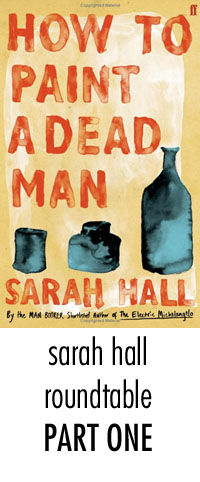
 A book of this type is difficult to discuss in a collective manner without bringing one’s own subjective viewpoint into the larder. So I shall do my best to convey some initial thoughts and impressions as a starting point, with the hope that other views will mesh and rustle with multiple truths.
A book of this type is difficult to discuss in a collective manner without bringing one’s own subjective viewpoint into the larder. So I shall do my best to convey some initial thoughts and impressions as a starting point, with the hope that other views will mesh and rustle with multiple truths. 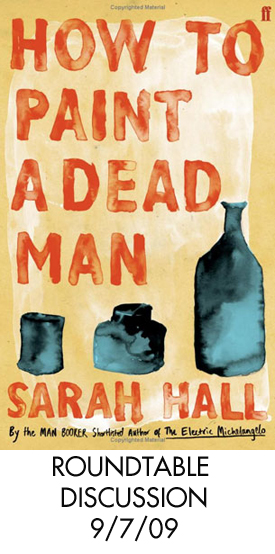
 This is just a reminder that, next week, we’ll be devoting this website to a detailed roundtable discussion of Sarah Hall’s How to Paint a Dead Man. The discussion, now in progress, has generated interesting asides on epistemological obstacles, whether second-person perspective is annoying, Procrustean plot structures, Fascist flower girls, The Breakfast Club, Bright Lights, Big City, still life vs. real life, the ineffable nature of artists, David Mitchell’s Cloud Atlas, being “an ambitious little prick” in relation to literature, William Faulkner vs. Virginia Woolf, Led Zeppelin, John Updike’s rules for book reviewing, “failures,” and numerous muted connections throughout the book.
This is just a reminder that, next week, we’ll be devoting this website to a detailed roundtable discussion of Sarah Hall’s How to Paint a Dead Man. The discussion, now in progress, has generated interesting asides on epistemological obstacles, whether second-person perspective is annoying, Procrustean plot structures, Fascist flower girls, The Breakfast Club, Bright Lights, Big City, still life vs. real life, the ineffable nature of artists, David Mitchell’s Cloud Atlas, being “an ambitious little prick” in relation to literature, William Faulkner vs. Virginia Woolf, Led Zeppelin, John Updike’s rules for book reviewing, “failures,” and numerous muted connections throughout the book.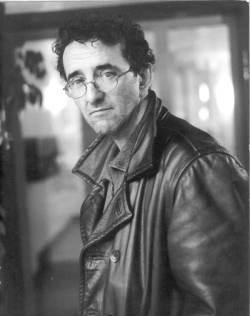
 What follows is an alphabetical list of the books that, in my view, mattered the most in 2008. You’ll note that Roberto Bolaño’s 2666 is not on this list. Why is that? Yes, I took the book with me during my Thanksgiving vacation. But I made a deliberate decision to not read it until next year. I assure you that this was not some fashionably contrarian decision. The 25 pages I’ve read have indeed been quite interesting, and I remain confident that the remaining 875 pages will prove to be more gripping than the world’s most dependable dentures. I’m certain I’ll become one of those wild-eyed acolytes naming my firstborn son “Roberto” in honor of the great dead author who may or may not have been a heroin junkie. But I’m very much of the belief that good reading involves looking between the cracks and not always reading the obvious titles. So I have decided to put off 2666 until next year, where I can read this important novel without getting lost in the hype, thereby recusing myself from any possible ethical qualms. Besides, the book needs no love from me. It continues to be heralded as the Second Coming. And I’m waiting for the FSG publicists to work their magic and have Bolaño return unexpectedly from the grave.
What follows is an alphabetical list of the books that, in my view, mattered the most in 2008. You’ll note that Roberto Bolaño’s 2666 is not on this list. Why is that? Yes, I took the book with me during my Thanksgiving vacation. But I made a deliberate decision to not read it until next year. I assure you that this was not some fashionably contrarian decision. The 25 pages I’ve read have indeed been quite interesting, and I remain confident that the remaining 875 pages will prove to be more gripping than the world’s most dependable dentures. I’m certain I’ll become one of those wild-eyed acolytes naming my firstborn son “Roberto” in honor of the great dead author who may or may not have been a heroin junkie. But I’m very much of the belief that good reading involves looking between the cracks and not always reading the obvious titles. So I have decided to put off 2666 until next year, where I can read this important novel without getting lost in the hype, thereby recusing myself from any possible ethical qualms. Besides, the book needs no love from me. It continues to be heralded as the Second Coming. And I’m waiting for the FSG publicists to work their magic and have Bolaño return unexpectedly from the grave.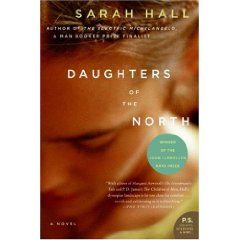 Sarah Hall, Daughters of the North: Recently, Gavin Grant helpfully reminded me that, as good as Daughters of the North is, there were plentiful feminist titles from the 1970s that went much further in their political ambition and sausage-slicing ideology. But Daughters of the North (known as The Carhullan Army in the UK) not only represents a natural evolution for Hall’s great writing talent, but it’s one of the few dytstopic novels of 2008 that, like Atwood’s bleak ball-busting pair (Oryx & Crake; The Handmaid’s Tale), I don’t believe will end up as a time capsule. (For more about this book, see my essay on Sarah Hall’s books for
Sarah Hall, Daughters of the North: Recently, Gavin Grant helpfully reminded me that, as good as Daughters of the North is, there were plentiful feminist titles from the 1970s that went much further in their political ambition and sausage-slicing ideology. But Daughters of the North (known as The Carhullan Army in the UK) not only represents a natural evolution for Hall’s great writing talent, but it’s one of the few dytstopic novels of 2008 that, like Atwood’s bleak ball-busting pair (Oryx & Crake; The Handmaid’s Tale), I don’t believe will end up as a time capsule. (For more about this book, see my essay on Sarah Hall’s books for 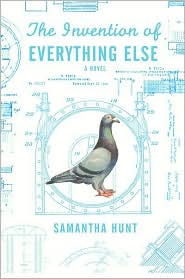 Samantha Hunt, The Invention of Everything Else: Like the work of Scarlett Thomas and Richard Powers, Samantha Hunt’s second novel is unapologetically concerned with communicating a sense of informative wonder to the reader. The book concerns Nikola Tesla’s last days in 1943, and a young chambermaid’s to understand him while her father tries to build a time machine to contact his dead wife. This unusual story, which also features several enjoyable glimpses of excitable people indulging in questionable pursuits (including an astutely realized old-time radio show), asks us to consider how much faith we should place in the crackpots of our world. Are great minds any crazier than the rapacious money men who exploit them? Would our nation be thriving right now if we dared to listen to those who are regularly discounted? (See also
Samantha Hunt, The Invention of Everything Else: Like the work of Scarlett Thomas and Richard Powers, Samantha Hunt’s second novel is unapologetically concerned with communicating a sense of informative wonder to the reader. The book concerns Nikola Tesla’s last days in 1943, and a young chambermaid’s to understand him while her father tries to build a time machine to contact his dead wife. This unusual story, which also features several enjoyable glimpses of excitable people indulging in questionable pursuits (including an astutely realized old-time radio show), asks us to consider how much faith we should place in the crackpots of our world. Are great minds any crazier than the rapacious money men who exploit them? Would our nation be thriving right now if we dared to listen to those who are regularly discounted? (See also  Ed Park, Personal Days: Long-time readers of this site will know that Good Man Park and I have carried out a strange interplay in the blogosphere. But I truly didn’t expect the Other Ed (or am I the Other Ed?) to knock this one out of the park. This office novel atones for Joshua Ferris’s overrated novel, Then We Came to the End, by offering crazy literary experiments (such as one section composed of a relentless pages-long sentence “written” by a worker who lacks a period on his keyboard), and permitting Good Man Park to flex his giddiness in fictive form. My only quibble with this novel is that Park may be self-censoring himself a tad about the horrors of office life, but it’s a small point that will hopefully be rectified in future novels. (See also
Ed Park, Personal Days: Long-time readers of this site will know that Good Man Park and I have carried out a strange interplay in the blogosphere. But I truly didn’t expect the Other Ed (or am I the Other Ed?) to knock this one out of the park. This office novel atones for Joshua Ferris’s overrated novel, Then We Came to the End, by offering crazy literary experiments (such as one section composed of a relentless pages-long sentence “written” by a worker who lacks a period on his keyboard), and permitting Good Man Park to flex his giddiness in fictive form. My only quibble with this novel is that Park may be self-censoring himself a tad about the horrors of office life, but it’s a small point that will hopefully be rectified in future novels. (See also